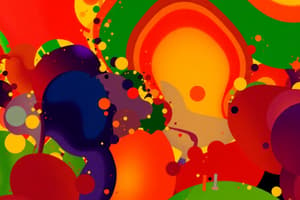Podcast
Questions and Answers
What is the primary function of color correction in image manipulation?
What is the primary function of color correction in image manipulation?
- Adjusting brightness and contrast
- Removing blemishes and scars
- Adjusting color casts, saturation, and hue (correct)
- Combining multiple images into one
What is the main characteristic of non-linear interactive media?
What is the main characteristic of non-linear interactive media?
- User-controlled sequence of events (correct)
- Real-time response to user input
- Pre-defined sequence of events
- A combination of linear and interactive elements
Which stage of video production involves scriptwriting and location scouting?
Which stage of video production involves scriptwriting and location scouting?
- Post-production
- Production
- Distribution
- Pre-production (correct)
What is the primary technique used in traditional animation?
What is the primary technique used in traditional animation?
What is the primary function of compression in audio processing?
What is the primary function of compression in audio processing?
Flashcards are hidden until you start studying
Study Notes
Image Manipulation
- Definition: Altering or enhancing digital images using software
- Techniques:
- Editing: adjusting brightness, contrast, and color balance
- Retouching: removing blemishes, scars, or unwanted objects
- Compositing: combining multiple images into one
- Color correction: adjusting color casts, saturation, and hue
- Software:
- Adobe Photoshop
- GIMP
- Sketch
- Applications:
- Photography
- Graphic design
- Advertising
- Social media
Interactive Media
- Definition: Media that responds to user input or interaction
- Types:
- Linear: pre-defined sequence of events
- Non-linear: user-controlled sequence of events
- Interactive: real-time response to user input
- Examples:
- Video games
- Virtual reality (VR) and augmented reality (AR) experiences
- Interactive websites and web applications
- Technologies:
- JavaScript
- HTML5
- CSS3
Video Production
- Definition: Creating video content using cameras, lighting, and editing software
- Pre-production:
- Scriptwriting
- Storyboarding
- Location scouting
- Production:
- Camera operation
- Lighting setup
- Sound recording
- Post-production:
- Video editing
- Sound design
- Color grading
- Software:
- Adobe Premiere Pro
- Final Cut Pro
- DaVinci Resolve
Animation
- Definition: Creating the illusion of movement through sequential images
- Techniques:
- Traditional animation: hand-drawn or hand-painted frames
- Computer-generated imagery (CGI): 3D modeling and rendering
- Stop-motion: manipulating objects frame-by-frame
- Types:
- 2D animation
- 3D animation
- Motion graphics
- Software:
- Adobe Animate
- Blender
- Autodesk Maya
Audio Processing
- Definition: Enhancing or altering audio signals using software or hardware
- Techniques:
- Equalization: adjusting frequency response
- Compression: controlling dynamic range
- Reverb: adding ambiance or space
- Applications:
- Music production
- Post-production for film and television
- Live sound reinforcement
- Software:
- Adobe Audition
- Ableton Live
- Logic Pro X
Image Manipulation
- Image manipulation is the process of altering or enhancing digital images using software.
- Techniques used in image manipulation include editing, retouching, compositing, and color correction.
- Editing involves adjusting brightness, contrast, and color balance.
- Retouching involves removing blemishes, scars, or unwanted objects.
- Compositing involves combining multiple images into one.
- Color correction involves adjusting color casts, saturation, and hue.
- Software used in image manipulation includes Adobe Photoshop, GIMP, and Sketch.
- Applications of image manipulation include photography, graphic design, advertising, and social media.
Interactive Media
- Interactive media responds to user input or interaction.
- Types of interactive media include linear, non-linear, and interactive media.
- Linear media follows a pre-defined sequence of events.
- Non-linear media follows a user-controlled sequence of events.
- Interactive media responds to user input in real-time.
- Examples of interactive media include video games, virtual reality (VR) and augmented reality (AR) experiences, and interactive websites and web applications.
- Technologies used in interactive media include JavaScript, HTML5, and CSS3.
Video Production
- Video production involves creating video content using cameras, lighting, and editing software.
- The pre-production stage involves scriptwriting, storyboarding, and location scouting.
- The production stage involves camera operation, lighting setup, and sound recording.
- The post-production stage involves video editing, sound design, and color grading.
- Software used in video production includes Adobe Premiere Pro, Final Cut Pro, and DaVinci Resolve.
Animation
- Animation involves creating the illusion of movement through sequential images.
- Techniques used in animation include traditional animation, computer-generated imagery (CGI), and stop-motion.
- Traditional animation involves hand-drawn or hand-painted frames.
- Computer-generated imagery (CGI) involves 3D modeling and rendering.
- Stop-motion involves manipulating objects frame-by-frame.
- Types of animation include 2D animation, 3D animation, and motion graphics.
- Software used in animation includes Adobe Animate, Blender, and Autodesk Maya.
Audio Processing
- Audio processing involves enhancing or altering audio signals using software or hardware.
- Techniques used in audio processing include equalization, compression, and reverb.
- Equalization involves adjusting frequency response.
- Compression involves controlling dynamic range.
- Reverb involves adding ambiance or space.
- Applications of audio processing include music production, post-production for film and television, and live sound reinforcement.
- Software used in audio processing includes Adobe Audition, Ableton Live, and Logic Pro X.
Studying That Suits You
Use AI to generate personalized quizzes and flashcards to suit your learning preferences.




